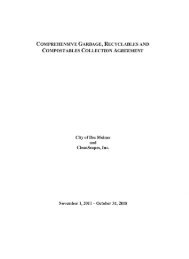CITY OF DES MOINES SHORELINE MASTER PROGRAM
CITY OF DES MOINES SHORELINE MASTER PROGRAM
CITY OF DES MOINES SHORELINE MASTER PROGRAM
You also want an ePaper? Increase the reach of your titles
YUMPU automatically turns print PDFs into web optimized ePapers that Google loves.
Des Moines Shoreline Master Program<br />
fish or wildlife habitat;<br />
7. Waters of the state as defined in Title 222 WAC;<br />
8. Lakes, ponds, streams, and rivers planted with game fish by a governmental or tribal<br />
entity; and<br />
9. State natural area preserves and natural resource conservation areas as defined,<br />
established, and managed by the Washington Department of Natural Resources.<br />
Flood plain 1 . Synonymous with one hundred-year flood plain, meaning that land area<br />
susceptible to inundation with a one percent chance of being equaled or exceeded in any given<br />
year. The limit of this area shall be based upon flood ordinance regulation maps or a reasonable<br />
method which meets the objectives of the act.<br />
Forest management practices 2 . Those methods used for the protection, production and cutting<br />
of timber or bush.<br />
Geologically hazardous areas 4 . Erosion hazard areas, landslide hazard areas, or seismic hazard<br />
areas as defined by the SMP.<br />
Geologically unstable 4 . The relative instability of a shoreform or land form for development<br />
purposes over the long term or the intended life of any proposed structure. Soil, slope, ground or<br />
surface water, other geologic conditions, vegetation and effects of development are common<br />
factors that contribute to instability. Areas characterized by banks or bluffs composed of<br />
unconsolidated alluvial or glacial deposits (till and drift material), or bluffs composed of<br />
unconsolidated alluvial or glacial deposits (till and drift material), severely fractured bedrock,<br />
active and substantial erosion, substantially deformed trees and shrubs, or active or inactive earth<br />
slides are likely to be considered geologically unstable.<br />
Geotechnical report 1 . Also referred to as a “geotechnical analysis,” meaning a scientific study<br />
or evaluation conducted by a qualified expert that includes a description of the ground and<br />
surface hydrology and geology, the affected land form and its susceptibility to mass wasting,<br />
erosion, and other geologic hazards or processes, conclusions and recommendations regarding<br />
the effect of the proposed development on geologic conditions, the adequacy of the site to be<br />
developed, the impacts of the proposed development, alternative approaches to the proposed<br />
development, and measures to mitigate potential site-specific and cumulative geological and<br />
hydrological impacts of the proposed development, including the potential adverse impacts to<br />
adjacent and down-current properties. Geotechnical reports shall conform to accepted technical<br />
standards and must be prepared by qualified professional engineers or geologists who have<br />
professional expertise about the regional and local shoreline geology and processes.<br />
Grade, average level 3 . The average of the finished ground level at the center of all exterior<br />
walls of a building. In case walls are parallel to and within five feet of a sidewalk, the sidewalk<br />
shall be considered the finished ground level.<br />
Grading 1 . The movement or redistribution of the soil, sand, rock, gravel, sediment, or other<br />
material on a site in a manner that alters the natural contour of the land.<br />
KEY: 1. RCW or WAC 2. 1988 SMP Glossary 3. City Zoning Code 4. New Definition<br />
Department of Ecology approval effective November 1, 2010<br />
120 Adopted by City of Des Moines Ordinance No. 1502



